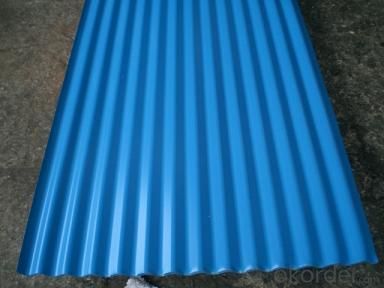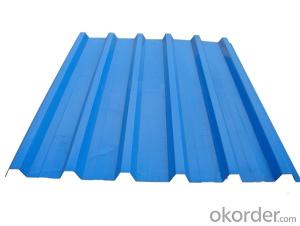Metal Roofing Galvanized Color-coated Sheet
- Loading Port:
- Guangzhou
- Payment Terms:
- TT or LC
- Min Order Qty:
- 1000 m²
- Supply Capability:
- 200000 m²/month
OKorder Service Pledge
OKorder Financial Service
You Might Also Like
Introduction
A metal roof is a roofing system made from metal piece, or tiles. It is a component of the building envelope.Metal roofs protect buildings.
Specifications
metal roofing galvanized color-coated sheet
1 Material:PPGI
2. Long life: 15-20 years
3.Lenth can be customized
Product Description
The Characteristics of our Color Steel Glazed Tiles
It is imitated ancient glazed tiles,with beatiful appearance, Many colors available, with elegant and noble looking.
Easy to be maintained and long life.
It is light, easy to be installed and dismentale.
It has the characteristics of fireproof and resistance of wind.
More suitable for coastal areas.
It can be recycled and good for environments.
Size
width: 840mm
thickness: 0.3-1.2mm
length: as customer’s requirement
expand width: 1000mm
appearance: Colourful,smooth, bright
surface treatment: coated
color: red, or as your requirements

- Q:What is the average cost of steel sheets per square foot?
- The cost of steel sheets per square foot can differ significantly due to various factors, including the type of steel, thickness, size, and market conditions. Nevertheless, as of 2021, the price range for steel sheets averages from $5 to $20 per square foot. It is crucial to acknowledge that this estimate is broad, and prices may vary depending on the location, supplier, and other market aspects. Consequently, it is advisable to collect quotes from multiple suppliers in order to obtain an accurate and current cost for steel sheets per square foot.
- Q:What is the lifespan of steel sheets?
- The lifespan of steel sheets can vary depending on various factors such as the specific type of steel, the quality of the sheets, the environmental conditions they are exposed to, and the level of maintenance and care provided. However, with proper installation and maintenance, steel sheets can have a lifespan of several decades or more.
- Q:What is the typical weather resistance of a steel sheet?
- The typical weather resistance of a steel sheet depends on its specific composition and surface treatment. However, in general, steel sheets are known for their excellent weather resistance. They are often coated with protective layers such as zinc or paint, which enhance their ability to withstand harsh weather conditions such as rain, snow, and UV radiation. This coating acts as a barrier, preventing moisture from penetrating the steel and causing corrosion. Furthermore, steel sheets are typically designed to be durable and long-lasting, making them a reliable choice for outdoor applications exposed to various weather elements.
- Q:Can steel sheets be used for structural applications?
- Yes, steel sheets can be used for structural applications. Steel sheets are commonly used in construction and engineering projects due to their strength, durability, and versatility. They can be fabricated into various shapes and sizes to suit different structural requirements, providing stability and support in buildings, bridges, and infrastructure.
- Q:Are the steel sheets perforated or solid?
- The steel sheets are perforated.
- Q:What are the potential drawbacks of using steel sheets?
- There are several potential drawbacks of using steel sheets in various applications. Firstly, steel sheets are prone to corrosion. If not properly protected or coated, steel sheets can rust when exposed to moisture or certain environmental conditions. This can significantly affect their structural integrity and lifespan. Secondly, steel sheets can be heavy and difficult to handle. This can pose challenges during transportation, installation, and maintenance. The weight of steel sheets may also limit their use in certain applications where weight restrictions are in place. Additionally, steel sheets can be expensive compared to other materials. The cost of steel production, processing, and customization can be higher than alternative materials, making steel sheets less financially viable in some projects. Another potential drawback of steel sheets is their limited design flexibility. Steel sheets are often manufactured in standard sizes and shapes, which may not always meet specific design requirements. Modifying steel sheets can be time-consuming and costly, limiting their adaptability for unique or complex projects. Moreover, steel sheets have a relatively high thermal conductivity. This means that they can transfer heat quickly, making them less effective in providing insulation. In applications where thermal insulation is crucial, alternative materials may be more suitable. Lastly, steel sheets are not environmentally friendly. The production of steel involves significant energy consumption and carbon emissions. Additionally, the extraction and mining of raw materials used in steel production can have detrimental effects on the environment. Overall, while steel sheets have numerous advantages such as strength and durability, it is important to consider these potential drawbacks when choosing the appropriate material for a specific application.
- Q:What are the different types of steel sheet surface coatings for corrosion resistance?
- There are several types of steel sheet surface coatings available for corrosion resistance, including galvanized coatings, zinc-rich coatings, aluminum coatings, and organic coatings such as paint or epoxy. Each coating offers unique benefits and application suitability depending on the specific requirements and environmental conditions.
- Q:What is the process of perforating steel sheets?
- Perforating steel sheets involves the use of specialized machinery to create a pattern of holes or perforations in the sheet. This process typically involves feeding the steel sheet into the machine, where it is clamped and then pierced with high-speed punches or drill-like tools. The size, shape, and arrangement of the holes can be customized based on specific requirements. This perforation process can be used for various applications such as ventilation, filtration, acoustic panels, decorative purposes, or as a way to reduce weight in structural components.
- Q:How do steel sheets perform in terms of vibration resistance?
- Due to their high stiffness and density, steel sheets generally exhibit excellent vibration resistance. The strong and rigid structure of steel enables it to effectively dampen vibrations, thereby enhancing its ability to resist a wide range of vibrations and minimize their amplification, a quality that is not found in other materials. Moreover, steel sheets can be further improved in terms of vibration resistance by employing techniques like incorporating damping materials or utilizing special coatings. As a result, steel sheets are widely regarded as a dependable option for applications that demand vibration resistance.
- Q:How do steel sheets handle expansion and contraction?
- Due to its unique properties, steel sheets are capable of managing expansion and contraction in a predictable and controlled manner. Steel is renowned for its remarkable strength and durability, enabling it to endure the forces exerted during expansion and contraction without compromising its structural integrity. When steel sheets are exposed to high temperatures, such as those experienced during welding or in extreme environmental conditions, expansion occurs. This expansion is a result of the accelerated movement of steel molecules due to heat, leading to an increase in size. However, steel possesses a relatively low coefficient of thermal expansion, causing it to expand less compared to materials like concrete or wood. This property makes steel an advantageous choice for applications where dimensional stability is crucial. To effectively manage expansion, steel sheets are often designed with expansion joints or gaps that allow for movement. These joints can be found in structures such as bridges, buildings, or pipelines. They are strategically placed to accommodate the anticipated expansion and contraction of steel sheets without causing damage or deformation. Furthermore, the ability of steel to contract is equally significant. When exposed to lower temperatures, steel sheets shrink or contract. Although this contraction is typically less noticeable than expansion, it still needs to be taken into consideration in engineering designs. Fortunately, the contraction of steel is generally within acceptable limits and does not compromise the material's structural integrity. Overall, steel sheets are engineered to effectively handle expansion and contraction. The combination of a low coefficient of thermal expansion and the presence of expansion joints allows steel to accommodate temperature fluctuations without inducing significant stress or deformation. This makes steel a reliable and versatile material for numerous industries, including construction, manufacturing, and infrastructure.
1. Manufacturer Overview |
|
|---|---|
| Location | |
| Year Established | |
| Annual Output Value | |
| Main Markets | |
| Company Certifications | |
2. Manufacturer Certificates |
|
|---|---|
| a) Certification Name | |
| Range | |
| Reference | |
| Validity Period | |
3. Manufacturer Capability |
|
|---|---|
| a)Trade Capacity | |
| Nearest Port | |
| Export Percentage | |
| No.of Employees in Trade Department | |
| Language Spoken: | |
| b)Factory Information | |
| Factory Size: | |
| No. of Production Lines | |
| Contract Manufacturing | |
| Product Price Range | |
Send your message to us
Metal Roofing Galvanized Color-coated Sheet
- Loading Port:
- Guangzhou
- Payment Terms:
- TT or LC
- Min Order Qty:
- 1000 m²
- Supply Capability:
- 200000 m²/month
OKorder Service Pledge
OKorder Financial Service
Similar products
New products
Hot products
Hot Searches
Related keywords





























